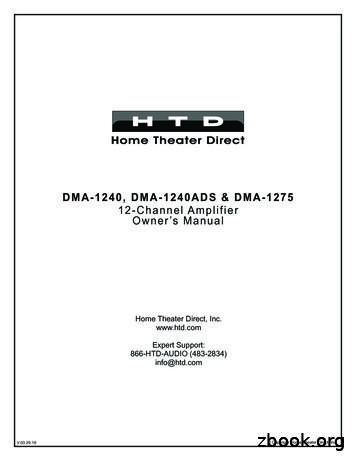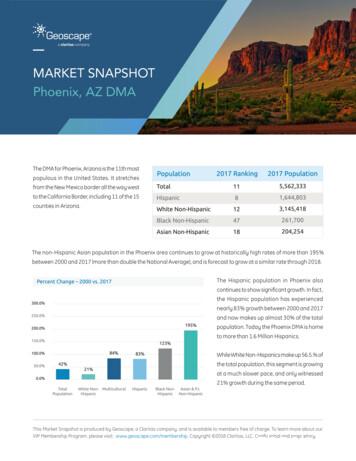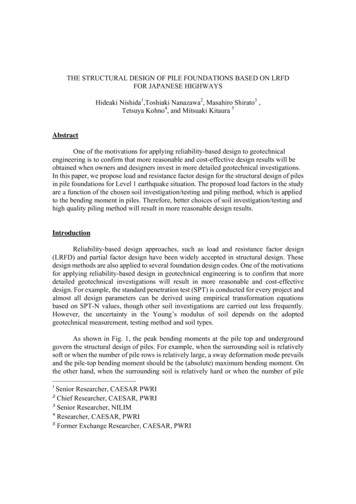DMA General Certification Overview
DMA General Certification OverviewWelcome to the DMA General Certification Overview course!This course was developed by the Office of Disability and Medical Assessment (DMA) and theVeterans Health Administration (VHA) Employee Education System (EES) as the initial web-basedtraining course for certification to be a Compensation and Pension (C&P) examiner.Practicing subject matter experts from VHA, the Veterans Benefits Administration (VBA), and theBoard of Veterans' Appeals (BVA) contributed as well.VHAThe Veterans Health Administration, also known as VHA, governs the medical treatment facilitieswithin the Department of Veterans Affairs. With nationwide medical centers (VAMCs), VHAprovides health care for Veterans. VHA manages one of the largest health-care systems in theUnited States. VAMCs within a Veterans Integrated Service Network (VISN) work together toprovide efficient, accessible health care to Veterans in their areas.BVAThe Board of Veterans' Appeals (the Board) is the component of the VA responsible for makingfinal decisions on behalf of the Secretary for claims for Veterans' benefits from all threeAdministrations and the Office of General Counsel that are presented to the Board for appellatereview. The Board's mission is to conduct hearings and issue timely decisions for Veterans andother Appellants in compliance with the requirements of law.VBAThe Veterans Benefits Administration (VBA) is responsible for providing a wide variety of benefitsand services to Veterans and Service-members through Regional Offices. Major benefits providedby VBA and authorized by Congress include service-connected disability compensation,nonservice-connected disability pension, burial assistance, survivors' benefits, rehabilitation andemployment assistance, education and training assistance, home loan guarantees, and lifeinsurance coverage.
WelcomeWelcome to the DMA General Overview course.The following panel of experts will appear throughout the course to explain important concepts.Brenda Howard, PA-C, MPASPhysician Assistant, Durham VA Healthcare SystemBrenda is a certified Physician Assistant. She has been a PA for 24 years and has 10 years ofC&P experience, 8 as the lead examiner at the Durham, NC VA facility. Brenda has been asubject matter expert (SME) on numerous DMA training courses related to C&P.Tina Skelly, Management Analyst, VBA Compensation ServiceTina is a Management Analyst with the Medical Disability Examination Quality and ProgramManagement Office. Tina has 24 years of C&P experience, 12 years at the Regional Officelevel, serving in both non-supervisory and supervisory roles, as well as 12 years at VBA CentralOffice. Tina has been a SME on numerous DMA training courses related to C&P.Jonathan Abrams, J.D., Special Counsel Office of KnowledgeManagement, Board of Veterans’ Appeals, Washington, DCJonathan is an attorney at the Board of Veterans’ Appeals and has worked as an AssociateCounsel in the Office of Appellate Operations for 5 years. As an Associate Counsel, Jonathandrafted appellate decisions on claims for veterans benefits and mentored new attorneys.Currently, he serves as a Special Counsel, providing lectures, mentoring newly hired attorneys,and managing other projects assigned.Jose Gavino Oliva, MDC&P Staff, VA Northern California Health Care SystemDr. Oliva was a Staff Surgeon and currently is a C&P examiner for the VA Northern CaliforniaHealth Care System. Dr. Oliva has been conducting C&P examinations since 2008.
Welcome (cont.)Let’s start with some background history on the DMA training.In 2006, the Compensation and Pension Examination Program Office (CPEP) was charged withdeveloping a mandatory certification training program for all Compensation and Pension examiners. Thepurpose was to design and provide baseline training for examiners on the C&P process.CPEP evolved into the Office of Disability and Medical Assessment, or DMA, and the certificationprogram has evolved into 9 mandatory courses and 16 optional exam-specific courses that focus on themost problematic examinations. All are designed to better equip examiners to conduct and reportratable C&P disability examinations for the Veterans Benefits Administration, or VBA.This course, DMA General Certification Overview, is the prerequisite course for all the others.Brenda Howard: “This course provides the foundation training for examiners. The other courses supportand expand their knowledge of the C&P process as they move through the certification curriculum.”Tina Skelly: “This is the first of a series of courses that clinicians must take before they conduct C&Pexaminations. Four other DMA courses are also required for basic certifications.”Brenda Howard: “The DMA Musculoskeletal Examinations course is also mandatory for examiners whoconduct exams involving any muscles or joints. Mental Health examiners have a requirement tocomplete the DMA PTSD and PTSD Mental Disorders courses. Clinicians who conduct TBI exams mustcomplete the DMA TBI Residuals exam course.”
This course was developed with input from the Veterans Health Administration, or VHA, the VBA, andthe Board of Veterans’ Appeals. The Board of Veterans’ Appeals can be referred to as “the Board” or asBVA.Why are all three groups involved?Jonathan Abrams: “All of us play a vital role in the C&P process, so it makes sense for us to develop thetraining jointly. We all contribute so the that the course can be comprehensive and address the majorconcerns of each administration and the Board.”Tina Skelly: “This course explains how VHA, VBA and the Board are involved in the C&P examinationprocess and what we need from clinicians who conduct C&P examinations.”What is the purpose of this DMA General Overview course?Jonathan Abrams: “The purpose is to provide a foundational understanding of the C&P process andwhat clinicians need to know, not only about conducting examinations, but equally important, thewriting and documenting of the C&P disability examination report. “What kinds of information do clinicians need to know?Tina Skelly: “They need to know why they are conducting a C&P examination because VBA needs criticalinformation for deciding a claim.”Jonathan Abrams: “They also need to know how a C&P examination is different from a treatment exam.It has a different purpose and audience. A C&P exam is a legal, as well as clinical, exam that providesevidence.”Brenda Howard: “Clinicians need to know the examiner’s role in VA’s disability claims process.Gathering evidence for VBA, such as a diagnosis, and how a condition impacts a veteran’s or servicemember’s work and daily activities.”Jonathan Abrams: “The clinicians taking this course will find out that there are legal terms used for C&Pexaminations. These are terms they may not be familiar with, like service connection, and thepresumption of soundness.”Tina Skelly: “There are also legal decisions that influence the examination process. The Court of Appealsfor Veterans Claims makes decisions that change how C&P clinicians evaluate veterans and servicemembers for claimed disabilities. Some of these cases include Sharpe, Correia, and Deluca. VA makespolicy based on those decisions.”Brenda Howard: “New examiners also need to know the guidelines for conducting compassionateexaminations with veterans and service-members. They need to know about policies and concerns as towhen chaperones are needed for an exam, or when a companion may attend. There are also legalrequirements and guidelines for conducting C&P exams, such as protocols to document the necessaryinformation. Additionally, they need to be familiar with the appropriate language and phrasing used indocumenting their exam findings, so that VBA and BVA can clearly interpret their exam report, and thusexpedite the veteran’s claim.”
Tina Skelly: “VBA may have specific questions for the examiner to answer. These questions come upwhile the claim is being developed. I should mention that VBA and BVA staff are not clinicians andcannot make medical decisions on their own—they must rely on the medical information provided byC&P examiners. Precise medical evidence is required to adjudicate claims.”How long will it take a new examiner to take this course?Brenda Howard: “It should take about 90 minutes to complete. However, this timeframe does notinclude knowledge checks or the final assessment.”Jonathan Abrams: “Clinicians must achieve a minimum score of 80% to complete the course. They cantake the final assessment more than once if they need to, but the questions will change each time.”
DMA TrainingIn support of improving the overall C&P disability examination process, DMA works jointlywith VHA EES to develop and update web-based training courses. The courses are developedthrough a collaborative effort with clinical, legal, policy, and administrative subject matterexperts, and designed to reflect current practice standards and required outcomes for ratable C&Pdisability examinations. All DMA web-based training courses are accredited and can be accessedon the VA Talent Management System (TMS) and the TRAIN Learning Network.VHA has a mandatory certification requirement for all clinicians designated to perform disabilityexaminations. All clinicians must complete a designated series of specific, mandatory trainingmodules and post-tests that are developed and approved by DMA. VHA Fee Basis and non-VHAcontract providers are held to the same training and certification standards and requirements.Information on certification requirements and certification registration can be accessed withinVA's internal network on the DMA Training page.Certification RequirementsThis DMA General Certification Overview course is the first of five mandatory courses requiredfor DMA certification:1.2.3.4.5.DMA General Certification OverviewDMA Military Sexual Trauma (MST) and the Disability Examination ProcessDMA Medical OpinionsDMA Aggravation OpinionsDMA Gulf War General Medical ExaminationThere are additional course requirements for DMA certification to conduct the following C&Pexaminations: C&P musculoskeletal (joint) examinations: DMA Musculoskeletal ExaminationC&P posttraumatic stress disorder examinations: DMA Initial PTSD ExaminationC&P initial mental health disorder examinations: DMA Initial Mental Disorders (IMD)ExaminationC&P traumatic brain injury (TBI) residuals examinations: DMA Traumatic Brain Injury ResidualsExaminationAll DMA training modules are listed in VA's Talent Management System (TMS) and the TRAINLearning Network in assign/self-assign curriculums.
Support for Your LearningThis course will take you approximately 90 minutes to complete.Clinical Quality Review ToolsThe content of this course is partly based on clinical quality review tools developed throughDMA's quality initiative and used to evaluate the clinical quality of C&P examinations asdocumented by examiners. The checklists, called Clinical Quality Review Tools, are alsodescribed in the Complete Your C&P Examination Report lesson. The actual forms are availableon the Quality page of the DMA intranet website.ResourcesThis course has resources you can access by selecting the Resources button at the bottom of thecourse interface. Resources can include reference citations, reference documents, the courseglossary, and web addresses for locating useful information.HelpSelect Help on the bottom of the course interface to access the Help page. This page hasinformation and tips to help you optimize your experience viewing this course.
Lesson 1 OverviewEvery C&P examination is a medical/legal examination conducted within the process ofdeveloping a Veteran's or Service-member's claim for benefits. The claims process involvesthe Veterans Health Administration (VHA), the Veterans Benefits Administration (VBA), andthe Board of Veterans' Appeals (BVA).This lesson will explain: how VHA, VBA, and BVA are involved in the claims process,the purpose of a C&P examination, andthe audience for your documentation of the examination.This lesson will also describe how you should interact with the Service-member and Veteran youexamine.
The Purpose of a C&P ExaminationA C&P disability examination is different from a treatment examination in its purpose andaudience. Review the accounts below from an expert panel explaining the purpose of the C&Pexamination and your documentation of it. You'll learn why VBA requests a C&P examination,and what VBA or BVA needs from you to adjudicate a Veteran's or Service-member's claim.Clinicians taking this course used to conducting treatment examinations with patients.Conducting C&P examinations will involve a new orientation. Let’s start with the treatmentexams that clinicians are familiar with—what is the purpose of a treatment exam?Brenda Howard: “The purpose is to assess overall health and determine ways in which toprevent and treat illnesses.”When the clinician writes the report for a treatment exam, who are they writing the report for?Brenda Howard: “Other treating providers, both generalists and specialists.”How would you describe the purpose of the C&P examination?Brenda Howard: “C&P examinations are conducted to provide clinical evidence for VBA and BVA. Therole of both VHA and contract examiners is to gather and document diagnostic and other clinicalevidence needed by VBA and BVA.”Does this mean the exam report or documentation protocol from a C&P examination is mainly for VBA?Tina Skelly: “Yes. VBA is the audience for the C&P examination report. We use the information from theexaminer to adjudicate the veteran or service member’s claim. We review all the evidence. We mayhave all we need depending on the evidence submitted, but if we need clinical evidence to help usdetermine for example whether a condition is related to service, or perhaps the current level of thecondition, we will request a C&P exam. We decide the claim based on all the evidence, not just theexamination, then we notify the claimant of our decision.”How is BVA involved in the C&P examination process?Jonathan Abrams: “We get involved if a veteran appeals his or her claim determination. If a claim isdenied, the veteran has an opportunity to appeal the decision. We have to determine if a denial isproper or not, and in order to do that we need certain evidence. We look at the C&P examination reportto see if the evidence we need is there, or if the medical opinion we need is sufficient. If the evidence issufficient, we will make a decision. If the information we need is not there, we remand—that is, we sendthe exam back for additional evidence that we’ve determined is missing. We might ask for a new exam,or a new medical opinion.”So we’ve established that VBA requests a C&P examination when they need evidence to develop aveteran’s or service-member’s claim for benefits. Then the examiner conducts the examination to gatherclinical evidence and report it to VBA. At that point, VBA uses the examination findings, along with otherevidence, to adjudicate the claim. BVA might be involved if VBA’s decision is appealed by the claimant?
Tina Skelly: “That’s right. We all have a vital role in putting the puzzle pieces together. This is a realchange from the treatment exams that clinicians are accustomed to.”
Purpose Knowledge CheckInstructions: Read the following questions and select the best answer(s) for each, then submityour responses for feedback.Question 1The Veterans Benefits Administration (VBA) requested an examination for Ms. Allen to gatherand document clinical evidence for adjudicating her disability claim. Select the examinationVBA is requesting.A. Treatment examinationB. C&P disability examinationQuestion 2VBA regularly adjudicates claims based only on evidence from a C&P examination.A. TrueB. FalseQuestion 3The Board of Veterans’ Appeals (BVA) may request a C&P examination to gather clinicalevidence when a Veteran appeals VBA’s determination for his or her claim.A. TrueB. False1. B. Option B is true because the purpose of a C&P disability examination is to gather and2.3.document clinical evidence for adjudicating a disability claim.B. VBA considers other evidence in addition to the documentation from a C&Pexamination.A. Option A is true because BVA becomes involved when a Veteran appeals thedetermination of their claim. BVA may request a C&P examination if clinical evidence isneeded.
A New Orientation for the ExaminerWhat is the role of a C&P examiner? How will you use your skills and training as you preparefor and conduct C&P examinations?Given that a C&P examination is part of a larger process that involves VBA, VHA, and BVA,it’s a different approach for the examiner. A new orientation.Dr. Oliva: “Transitioning to conducting C&P exams can be difficult at first, especially implementing courtdecision policies. One has to be patient and communicate with VBA or BVA if questions arise from therequested examination.”Give the distinction between a treatment exam and a C&P exam, what advice would you give newexaminers on how to leverage their clinical knowledge to best support the C&P exam process?Brenda Howard: “When we were trained in medicine we were trained to understand that certainconstellations of symptoms, physical signs, and historical information help lead us to diagnosticconclusions. The same thing is true in a C&P exam. We have to understand certain clinical diseaseprocesses and the pathophysiology that leads us to make a diagnosis. We have to use that same clinicalskill and knowledge to make diagnoses for C&P. But in C&P we have to take it a step further. We have tolook back at sometimes decades worth of documentation and determine if signs and symptoms fromyears ago were actually evidence of the current condition. We have to ask ourselves, did the event,illness or injury that happened to the veteran years ago eventually lead to the condition that the veteranhas now. If we don’t understand the totality of the pathophysiology or the nature and progression of anillness over time, it’s difficult to provide a conclusion for VBA. Our role is to make the connection anddetermine how these things are related to one another.Dr. Oliva: “Most clinicians are used to treating patients and addressing their symptoms, complaints andconcerns. The basis of a C&P exam is not to treat the veteran. The difference between treating a veteranand performing a C&P exam shifts the perspective from treatment towards determining the relationshipbetween past injury and a claimed condition. A lot of examiners may have difficulty making those leaps,but it comes with time. I would stress to new clinicians that our role is to make a connection anddetermine how these things are related to one another and to the veteran’s service. As in any clinicalsetting, compassion and openness remains important.”
New Orientation-Examiner Knowledge CheckInstructions: Read the following question and select the best answer(s), then submit yourresponse for feedback.Question 1Which of the following statements is not correct about C&P examiners?A. Examiners often use their understanding of disease processes and pathophysiology todetermine the relationship of a condition to a claimant's time in service.B. Examiners are not concerned with policies and court decisions during C&P examinations.C. Examiners sometimes look back at decades worth of documentation to determine if signsand symptoms from years ago were actually evidence of a current condition.D. Examiners communicate with VBA or BVA when they have questions about a requestedexamination.1. B. Option B is not true because examiners implement policies and court decisions duringC&P examinations.
A New Orientation for the Veteran or Service-MemberVeterans and Service-members are also accustomed to treatment examinations, so you'll need toguide them through C&P examinations. How can you be helpful to Veterans and Servicemembers if it's not about recommending ways to improve their physical or mental health?The C&P examination is also a different kind of exam than a veteran or service-member is used to. Howdo you work with veterans or service-members and their expectations?Brenda Howard: “In a treating exam generally I would have already established a rapport with thepatient. If it’s a C&P exam, I’m usually meeting the veteran or service-member for the first time andneed to establish a rapport. I explain the reason he or she is here, that they need to know from the startthis is a disability exam. As a medical professional, I tell them that I can’t recommend specifictreatments, but if I find anything abnormal during the exam I will alert them to get treatment. If theveteran is eligible for VA care, I can help facilitate them getting care at the VA, and if there’s a medicalemergency we’ll treat the emergency. I encourage them to ask questions throughout the appointment.”Dr. Oliva: “C&P examinations are distinct from what clinicians are accustomed to doing. C&Pexaminations are conducted on veterans or service-members who have disability claims. Once again,our role as clinicians is not to treat but to medically evaluate claims. However, as Brenda has said, if wesee something abnormal we would advise the veteran they need to seek medical attention. I try my bestto be clear with a veteran or service-member about my role as a physician and what to expect duringand after the C&P examination. I encourage the veteran or service-member to ask questions during theexam. If they bring a spouse, friend, or other family member I make sure that they too understand.”What should new examiners keep in mind when working with a veteran or service-member?Brenda Howard: “The examiner should also avoid forming predetermined notions based on reviewingrecords and other evidence. Approach the exam with an open mind. Before meeting a veteran I have tothink about what experiences they’ve had that can affect how they react during the exam. They mayhave had negative experiences with the VA in the past, or they may have anxiety about coming to anexam at the VA because it triggers memories of their time in service. Before meeting the veteran Ireview their records so that I can be aware of any history and any conditions they may have, such asPTSD. I try to anticipate their sensitivities in advance. For example, I ask if it’s okay to have the doorclosed before beginning the exam.”Do you have additional advice for examiners about how to work with veterans and service-members?Dr. Oliva: “Yes. C&P benefits, whether monetary or medical, are important to veterans and servicemembers and their families. It is imperative that we provide them high quality examinations, as well asthoughtful and compassionate service. Many times we may be their first contact within the VA,therefore we need to be informative and transparent so that veterans and service-members can walkaway feeling good about their experience.”Brenda Howard: “Yes, every veteran is deserving of our time, attention, and best effort in every historytaken, and every exam performed, every opinion provided. With every veteran I think, if this were myfamily member, how would I want them to be served?”
New Orientation-Veteran Knowledge CheckInstructions: Read the following questions and select the best answer(s) for each, then submityour responses for feedback.Question 1Examiners can help Service-members and Veterans understand the purpose of their C&Pexamination by explaining what to expect during and after the examination. What else shouldexaminers say? Select all that apply.A. Explain the purpose of a disability examination.B. Offer to recommend treatments for conditions found on examination.C. Explain the examiner's role in a C&P examination.D. Encourage questions at any time.Question 2Based on what you learn about the claimant before a C&P exam, which action should you avoid?A. Be sensitive to a claimant's conditions, such as PTSDB. Form an opinion about the claimant or the claim before the exam appointment1. A, C, & D. Option B is not true because an examiner cannot offer treatments.2. B. Forming an opinion about the claimant or claim prior to a C&P examination is to beavoided. Approach the examination with an open mind.
Lesson 1 SummaryThis lesson explained that every C&P examination takes place within a larger C&P claimsprocess that involves VHA, VBA, and BVA.Moreover, C&P examinations are conducted to gather evidence for a Veteran's or Servicemember's claim for benefits and adjudicators from VBA and in some cases, BVA, are theaudience for the examination report. In addition, there are recommendations for how to interactwith Veterans and Service-members.Now that you've finished this lesson, you should be able to: Compare the purpose of a treatment examination and a C&P examination.Recognize the role of the examiner in the disability claims process.Recognize guidelines for interacting with Veterans or Service-members during C&P disabilityexaminations.
Lesson 2 OverviewThis lesson will explain your role as an examiner within the five-step C&P disability claimsprocess.Because C&P examinations are legal as well as clinical in nature, you'll need to become familiarwith terms from the United States Code (USC) and Code of Federal Regulations (CFR) that arecommonly used by VBA in communicating to you about an examination. Those terms will bedefined.The names of several court cases have also become part of the vocabulary used in C&P clinicsbecause they have influenced how C&P examinations are conducted and documented. Thislesson will introduce you to some of these cases.
Claims for BenefitsVeterans apply to VBA for benefits that can include education and training, home loans, lifeinsurance, pension, and compensation. The Veteran may apply for any of these benefitsthemselves or with the assistance of a Veterans Service Organization, or VSO. The benefits canmake a difference for Veterans in different phases of their lives. For instance, some Veteransmay be transitioning to civilian life while others may be buying their first home. It might be thata Veteran at any phase of his or her life is applying for assistance for activities of daily living.VA disability compensation provides monthly benefits to a Veteran in recognition of the effectsof disabilities, diseases, or injuries incurred or aggravated during active military service. Beingawarded compensation for his or her claim validates the Veteran's experience.Disability examinations are needed for both compensation and pension onA tax-free monetary benefit paid to Veterans with disabilities that are the result of a disease or injuryincurred or aggravated during active military service. The benefit amount is graduated according tothe degree of the Veteran's disability on a scale from 10 percent to 100 percent, in increments of 10percent. Compensation may also be paid for disabilities that are considered related or secondary todisabilities that occurred in service and for disabilities presumed to be related to circumstances ofmilitary service, even though they may arise after service.Special MonthlyCompensation(SMC)An additional tax-free benefit that can be paid to Veterans, their spouses, surviving spouses andparents. For Veterans, SMC is a higher rate of compensation paid due to special circumstances suchas the need of aid and attendance by another person or by a specific disability such as the loss of useof a hand or leg. For spouses and surviving spouses, this benefit is commonly referred to as aid andattendance and is paid based on the need of aid and attendance by another person.Claims Based onSpecialCircumstancesVeterans may be eligible for other types of disability compensation once a disability has beendetermined to be service connected. Special VA disability compensation programs include:individual unemployability, automobile allowance, clothing allowance, prestabilization,hospitalization, convalescence, dental, and birth defects.PensionPension is a needs-based benefit for wartime Veterans with limited or no income who are age 65 orolder, or who have a permanent and total disability. It may provide income for Veterans and theirloved ones.
Where You Fit In the C&P ProcessWhen a Veteran or Service-member files a C&P disability claim with VBA, a five-step processbegins. Your involvement would begin in Step 3, after a Veterans Service Representative, orVSR, reviews the claim. The VSR will request a C&P examination if clinical evidence is needed.If this is the case, the VSR will submit a Request for Examination to your facility. For complexclaims, a Rating Veterans Service Representative (RVSR) submits the Request. The RVSR isalso the adjudicator who decides the claim.Your role will be to gather clinical evidence for the claim and report it to VBA. After youcomplete a C&P examination and report your findings to VBA, VBA will adjudicate, or decidethe claim based on all evidence, including your examination report.Step 1: Claim Received. BA notifies the Veteran or Service-member that VBA has received hisor her claim.Step 2: Initial Review. A VSR or RVSR reviews the claim. A decision will be made unless moreevidence is needed.Step 3: Evidence Gathering, Review, and Decision. The VSR or RVSR will:-ask for evidence from the claimant, health care providers, governmental agencies,or othersreview the evidencemake a decisionIf VBA needs more evidence during the review, the claim may return to this step more thanonce.Step 4: Preparation for Notification. VBA will prepare the claimant's entire claim decisionpacket for mailing.Step 5: Claim Complete. VBA will send the Veteran or Service-member a packet by U.S. mailthat includes details of the decision on the claim.
C&P Process Knowledge CheckInstructions: Read the following question and select the best answer(s), then submit yourresponse for feedback.Question 1VBA requests a C&P examination during which step in the disability claim
This DMA General Certification Overview course is the first of five mandatory courses required for DMA certification: 1. DMA General Certification Overview 2. DMA Military Sexual Trauma (MST) and the Disability Examination Process 3. DMA Medical Opinions 4. DMA Aggravation Opinions 5. DMA Gulf War General Medical Examination
PG 3 DMA-011 DMA-043 DMA-096 DMA-053 DMA-056 DMA-064 DMA-063 DMA-066 DMA-066B DMA-067 DMA-068 DMA-079 DMA-084 DMA-087 DMA-088
Different DMA for each surface type. Slide courtesy of Santa Barbara County and Dan Cloak. 1225 SF Existing Impervious Area. DMA-1. 3200 DMA-2. 3200 DMA-3: 3700 DMA-4. 12400 DMA-5: 500 DMA-6. 8500 DMA-7: 4200 Total 35700 1225 SF Existing Impervious Area. Slide courtesy of Santa Barbara County and Dan Cloak. Sizing - Treatment Only. DMA Name .
DMA interrupt handler are implemented in emlib, but callbacks can be registered by application emlib DMA config includes DMA interrupt handler Callback functions registered during DMA config 17. Hands-on task 1 - Basic Mode 1. Open an\fae_training\iar\dma.eww and got to adc_basic project 2. Run code and check that DMA- CHREQSTATUS[0] is set to 1
Linux - DMA buf Application Coprocessor libmetal Allocator (ION ) Remoteproc ioctl to import DMA buf Linux Kernel metal_shm_open() metal_shm_attach() metal_shm_sync DMA buf DMA buf fd DMA buf fd va, dev_addr DMA buf fd dev addr, size Sync_r/Sync_w, Ack RPMsg dev_addr, size Sync_r/Sync_w, Shm size Ack
CLASSIFIED ADVERTISING 400 East 11th Street Chattanooga, Tennessee 37403 (423) 757-6252 FAX (423) 757-6337 Market & Retail Trading Zones Adults in Percent TFP TFP Reach Weekly Times Free Press Readers Chatt. DMA of DMA Readers % in DMA DMA Chattanooga DMA 744,860 100.0% 312
The DMA-1240 (DMA-1275) is a 12-channel, multi-use, multi-zone power amplifier that is flexible and powerful enough to amplify every speaker in your whole-house audio system and/or home theater system. This amplifier delivers exceptionally
Over 27% of the Phoenix DMA is made of Millennials. The estimated average household income in 2018 is 80,116 Non-family households make up 33.34% of the Phoenix DMA. 42.71% of the households in the Phoenix DMA are comprised of a married couple with no children of their own. The average age of people living in the Phoenix DMA is 39.
in pile foundations for Level 1 earthquake situation. The proposed load factors in the study are a function of the chosen soil investigation/testing and piling method, which is applied to the bending moment in piles. Therefore, better choices of soil investigation/testing and high quality piling method will result in more reasonable design results. Introduction Reliability-based design .























